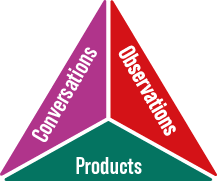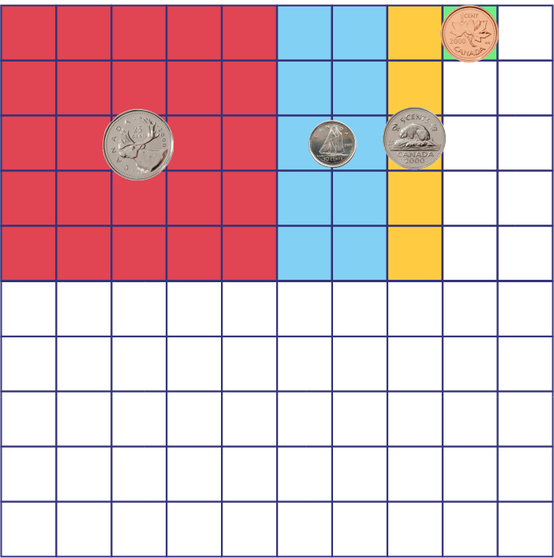F1. Money and Finances
Demonstrate an understanding of the value of Canadian currency.
Learning Situation: The Monster Box Ate My Coins!
Duration: 50 minutes
Overview
In this learning situation, students learn to recognize Canadian coins by discovering their various physical characteristics as well as their monetary value.
| Overall Expectation | Specific Expectation |
|---|---|
| F1. Financial Literacy
Demonstrate an understanding of the value of Canadian currency. |
F1.1 Identify the various Canadian coins up to 50¢ and coins and bills up to $50, and compare their values. |
| Preferred High-Impact Instructional Practices in Mathematics | Description |
|---|---|
|
Learning Goals, Success Criteria and Descriptive Feedback |
Before beginning this learning situation, it is essential to make the learning goals, based on the curriculum expectations and content, explicit so that they are known and understood by all students. This will ensure that students are aware of the learning goals of the lesson. The success criteria can then be developed and understood through a variety of instructional strategies, such as using examples of student work, co-constructing the success criteria, or self-assessing how the criteria have been met. These strategies allow for student engagement and a shared understanding of the steps needed to achieve the learning goals. It is important to make the learning goals and success criteria visible by posting them in the classroom for students to refer to throughout the lesson. Descriptive feedback related to the criteria provides the specific information students need to achieve the intended learning goals. By providing descriptive feedback on multiple occasions, educators help students develop the skills to assess their own learning and reflect on the criteria. In this learning situation, a good time for descriptive feedback is during the Active Learning phase. Students represent different coins using concrete and semi-concrete models to determine their value. Students work and communicate in small groups, and, with thoughtful questioning, educators check for understanding and direct students to the criteria to adjust or justify their work. During Review, some solutions may require descriptive feedback from the educator to ensure that the student has the necessary support to revise their thinking to apply to a new context. |
|
Math Conversations |
By planning lessons like this, which emphasize collaboration and groupwork, the math conversations are ongoing. These conversations allow students to express themselves and react to the mathematical ideas presented. The role of educators will be to ask open-ended, thought-provoking questions that stimulate thinking and allow for multiple responses. This interaction through questioning must be carefully planned to highlight key concepts, skills, or specific representations to promote student progress. Educators are encouraged to anticipate students' questions and answers in order to make the exercise even more strategic (for example, by anticipating some common errors). As soon as the learning situation begins, educators should ask questions that are accessible to all students and encourage them to share their ideas in the class group. As students are engaged in solving the problem, questioning and discussion should promote their justification as a group and develop their critical thinking. During Review, the questioning should support rich mathematical conversation in the whole group and provide educators with the opportunity to assess student understanding of the concepts being learned. |
|
Flexible Groupings |
Flexible groupings can foster collaboration and give students the opportunity to participate in rich mathematical conversations, learn from each other, and evolve their mathematical thinking. These structures allow students to work independently of the educator, while benefiting from the support of their peers. It is the intentional combination of large group, small group, pair, and individual work that can foster a rich mathematical learning environment. For this learning situation, the initial scenario can be completed individually, so that each student can handle and observe the coins at their own pace. During the Active Learning phase, small groups of two or three are preferable to encourage the participation of each student when comparing the value of the coins. Review in the whole class group allows students to hear the ideas of others, while bringing their own ideas to the discussion. The choice of flexible groupings can be adapted according to the needs of your class group. |
Prior Knowledge and Skills
To be able to complete this learning situation, students must be able to:
- Read and represent whole numbers from 0 to 50.
- Compare and order whole numbers to 50.
- Skip count by 1s, 2s, 5s, and 10s.
- Recognize some coins and Canadian dollar bills up to $50.
Learning Goal
At the end of this learning situation, students will be able to identify and compare the value of coins up to 50¢.
Possible Success Criteria Based on the Achievement Chart
| Skill | Success Criteria |
|---|---|
|
Knowledge and Understanding |
The student recognizes and names Canadian coins. |
|
Thinking |
The student chooses strategies to place the Canadian coins in ascending order. |
|
Communication |
The student explains observations of the size, shape, colour, texture, and value of the different coins, as well as the images found on the faces, and demonstrates mathematical reasoning. |
|
Application |
The student can use strategies to compare and place coins in ascending order by value. |
Materials
- an empty tissue box
- cardstock of various colours
- glue stick
- markers
- Canadian play money coin set
- base ten material
- interlocking cubes of three different colours
- Appendix 1 - Open Number Line
- Appendix 2 - Blank Model
- Appendix 3 - 5¢, 10¢, and 25¢ Coin Models
- Appendix 4 - Models of Bills up to $50 and Coins of $1 and Over
Mathematical Vocabulary
bills, hundred, heads, tails, ten, Canadian dollar, order, ascending order, coins, quantity, unit, value
Before Learning (Warm-Up) - Canadian Coins
Duration: approximately 20 minutes
Assessment can be carried out through…
Activate prior knowledge:
For this activity, students will have decorated their tissue (monster) boxes beforehand.
Insert a small amount of play Canadian coins into each student's monster box.
Have students reach into the box with one hand to touch the coins, one at a time, and guess what each is.
The student will state a prediction and justify it (for example, I think it's a dime because it's small and it has ridges on the
edge). Then, they remove the coin from the box to validate their answer.
Possible teacher questions include:
- As you handle the coins in your hands, what do you notice?
- What textures can you feel?
- What details do you see on the heads and tails sides?
- How did the different sizes and colours of coins help you to identify them?
- Can you recognize the image on the coin? What is the image and what does it represent?
- If one cube is worth 1 cent, how many interlocking cubes do you need to represent 5¢? 10¢? 25¢?
Active Learning (Exploration)
Duration: approximately 20 minutes
Assessment can be carried out through…
Put students in teams of two or three with the coins they collected during the Warm-Up activity.
Distribute interlocking cubes to students and ask them to construct concrete, proportional representations for the 5¢, 10¢ and 25¢ coins. Once students are familiar with the cube models, they can use the semi-concrete models found in Appendix 2 - Blank Model and Appendix 3 - 5¢, 10¢ and 25¢ Coin Models.
Note: It is important to talk about the 1¢ coin, as students need to understand that the unit of Canadian money is one cent and the coin to represent it is called the penny. The interlocking cube models allow students to visualize the value of various coins in relation to the unit 1¢.

Distribute Appendix 1 - Open Number Line.
Ask students to place each coin and its model in ascending order on their work surface.
Have students locate the value of each coin on the open number line, according to the models placed in ascending order on their work surface.
Encourage collaboration and participation.
Have students circulate to see other students' number lines.
Here are some possible questions:
- What numbers do you see on the coins? What might this tell us about each coin?
- Is it cents or dollars? How do you know?
- What is the smallest coin by size? Does it represent the smallest monetary value? How do you know?
- Which Canadian coin is worth the most? How do you know?
- Which Canadian coin has the lowest value? How do you know?
|
Possible Observations |
Possible Interventions |
|
Students have difficulty identifying coins and their value using the mathematical vocabulary taught. |
|
|
Students do not place the coins in ascending order of value. Students are unable to explain their ideas clearly. |
|
Review
Duration: approximately 10 minutes
Assessment can be carried out through…
Review the activity.
Review and explain the value of each coin and how it is identified by a number that is visible on the coin.
Check students' understanding by asking them to place the coins and their models in ascending order.
Discuss the importance of identifying coins and their value, especially when counting money or making purchases.
Ask students questions to deepen their thinking:
- How have you met the learning goals?
- What do the people and symbols on the coins and bills represent? Invite students to make connections to their own identity.
Consolidation of Learning
- Using Appendix 1.4 - Models of Bills up to $50 and Coins of $1 and Over, repeat the activity with bills and coins of at least $1,
using a number line from 0 to 50. Discuss where the $1 and $2 coins fit among the bills. - Taking turns drawing from the monster box, small groups of students can play Battle to compare values. This can be done
with bills up to $50. Have students explain their reasoning during the game.
Links to Other Curriculum Expectations
Number
B1.1 Read and represent whole numbers up to and including 50, and describe various ways they are used in everyday life.
B1.3 Compare and order whole numbers up to and including 50, in various contexts.
B1.5 Count to 50 by 1s, 2s, 5s, and 10s, using a variety of tools and strategies.
Data
D1.1 Sort sets of data about people or things according to one attribute, and describe rules used for sorting.
Differentiated Instruction and Universal Design for Learning
- Display math vocabulary words.
- Focus on one item to be recognized at a time.
- Provide visual support (reference) for students to identify coins and their value with greater ease.
- Ensure that the student is able to manipulate concrete materials and make connections to learning situations in the
Number strand.
For an Extra Challenge
- Compare the value of coins with the value of bills.
- Represent 50¢ in different ways using various coins.
- Represent $50 in different ways using coins and bills.
- Classify the coins according to an attribute and describe the classification criteria used. Repeat the exercise with the bills.
